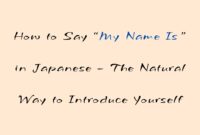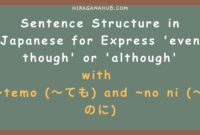What Are Transitive Verbs?
Transitive verbs are used when a subject performs an action on an object. In
Japanese, the object of an action is marked by the particle
“O” (を). This simple pattern is commonly used in daily
conversations.

Sentence Pattern: Subject + は (wa) + Object + を (O) + Verb
Here are some example sentences:
-
私はラジオを聞きます。
Watashi wa rajio o kikimasu.
I listen to the radio. -
お母さんは味噌を作りますか?
Okaasan wa miso o tsukurimasu ka?
Does my mother cook miso? -
おじいさんはテレビでニュースを見ます。
Ojiisan wa terebi de nyūsu o mimasu.
My grandfather watches the news on TV. -
本田さんは友達と車を洗います。
Honda-san wa tomodachi to kuruma o araimasu.
Mr. Honda washes the car with friends.
Explanation of Sentence Structure
-
Subject (Watashi/Okaasan/Ojiisan): The person performing
the action. - Particle “wa” (は): Marks the topic of the sentence.
-
Object (rajio/miso/nyūsu/kuruma, etc.): The item receiving
the action. - Particle “o” (を): Indicates the object of the action.
-
Verb (kikimasu/tsukurimasu/mimasu/araimasu): The action
being performed.
Vocabulary List
| Kanji | Hiragana | Romaji | Meaning |
|---|---|---|---|
| 私 | わたし | Watashi | I |
| ラジオ | ラジオ | Rajio | Radio |
| 聞きます | ききます | Kikimasu | Listen |
| お母さん | おかあさん | Okaasan | Mother |
| 味噌 | みそ | Miso | Miso soup |
| 作ります | つくります | Tsukurimasu | Make/Cook |
| おじいさん | おじいさん | Ojiisan | Grandfather |
| テレビ | テレビ | Terebi | Television |
| ニュース | ニュース | Nyūsu | News |
| 見ます | みます | Mimasu | Watch |
| 本田さん | ほんださん | Honda-san | Mr. Honda |
| 友達 | ともだち | Tomodachi | Friend |
| 車 | くるま | Kuruma | Car |
| 洗います | あらいます | Araimasu | Wash |
Tips for Learning Transitive Verbs
-
Master the Basic Pattern
Focus on the
“Subject + wa + Object + o + Verb” structure to
understand the foundation of Japanese grammar. -
Practice Listening and Speaking
Use online Japanese
learning platforms, whether free or paid, to improve your listening and
speaking skills. -
Apply It in Daily Life
Create simple sentences like
“I drink tea” or “She reads a book” to practice new vocabulary.
Practice Exercise
Translate the following sentences into Japanese:
- I eat sushi.
- Does he write a letter?
- My younger sibling reads manga.
- My friend plays the guitar.
Mastering transitive verbs is a gateway to understanding more complex Japanese
conversations. Through online courses, you can explore many variations of
these sentences for free. Moreover, understanding their meanings accurately is
essential for translating documents or dialogues.
By mastering this pattern, you can take significant steps forward in your
Japanese learning journey. Happy learning, and don’t forget to keep
practicing!


